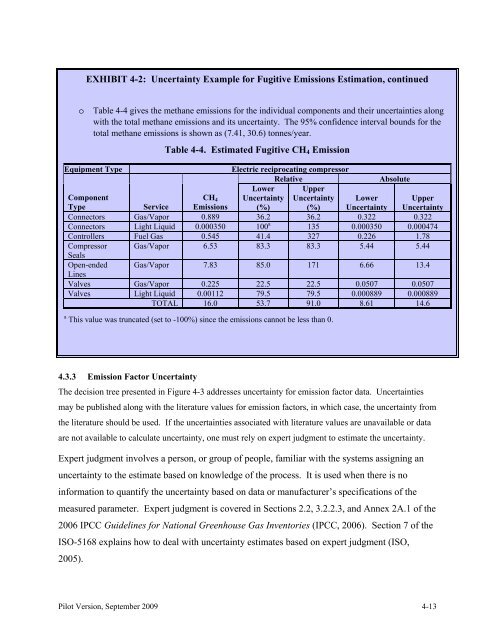addressing uncertainty in oil and natural gas industry greenhouse
addressing uncertainty in oil and natural gas industry greenhouse
addressing uncertainty in oil and natural gas industry greenhouse
You also want an ePaper? Increase the reach of your titles
YUMPU automatically turns print PDFs into web optimized ePapers that Google loves.
EXHIBIT 4-2: Uncerta<strong>in</strong>ty Example for Fugitive Emissions Estimation, cont<strong>in</strong>ued<br />
o<br />
Table 4-4 gives the methane emissions for the <strong>in</strong>dividual components <strong>and</strong> their uncerta<strong>in</strong>ties along<br />
with the total methane emissions <strong>and</strong> its <strong>uncerta<strong>in</strong>ty</strong>. The 95% confidence <strong>in</strong>terval bounds for the<br />
total methane emissions is shown as (7.41, 30.6) tonnes/year.<br />
Table 4-4. Estimated Fugitive CH 4 Emission<br />
Equipment Type<br />
Electric reciprocat<strong>in</strong>g compressor<br />
Relative<br />
Absolute<br />
Component<br />
Type<br />
Service<br />
CH 4<br />
Emissions<br />
Lower<br />
Uncerta<strong>in</strong>ty<br />
(%)<br />
Upper<br />
Uncerta<strong>in</strong>ty<br />
(%)<br />
Lower<br />
Uncerta<strong>in</strong>ty<br />
Upper<br />
Uncerta<strong>in</strong>ty<br />
Connectors Gas/Vapor 0.889 36.2 36.2 0.322 0.322<br />
Connectors Light Liquid 0.000350 100 a 135 0.000350 0.000474<br />
Controllers Fuel Gas 0.545 41.4 327 0.226 1.78<br />
Compressor Gas/Vapor 6.53 83.3 83.3 5.44 5.44<br />
Seals<br />
Open-ended Gas/Vapor 7.83 85.0 171 6.66 13.4<br />
L<strong>in</strong>es<br />
Valves Gas/Vapor 0.225 22.5 22.5 0.0507 0.0507<br />
Valves Light Liquid 0.00112 79.5 79.5 0.000889 0.000889<br />
TOTAL 16.0 53.7 91.0 8.61 14.6<br />
a This value was truncated (set to -100%) s<strong>in</strong>ce the emissions cannot be less than 0.<br />
4.3.3 Emission Factor Uncerta<strong>in</strong>ty<br />
The decision tree presented <strong>in</strong> Figure 4-3 addresses <strong>uncerta<strong>in</strong>ty</strong> for emission factor data. Uncerta<strong>in</strong>ties<br />
may be published along with the literature values for emission factors, <strong>in</strong> which case, the <strong>uncerta<strong>in</strong>ty</strong> from<br />
the literature should be used. If the uncerta<strong>in</strong>ties associated with literature values are unavailable or data<br />
are not available to calculate <strong>uncerta<strong>in</strong>ty</strong>, one must rely on expert judgment to estimate the <strong>uncerta<strong>in</strong>ty</strong>.<br />
Expert judgment <strong>in</strong>volves a person, or group of people, familiar with the systems assign<strong>in</strong>g an<br />
<strong>uncerta<strong>in</strong>ty</strong> to the estimate based on knowledge of the process. It is used when there is no<br />
<strong>in</strong>formation to quantify the <strong>uncerta<strong>in</strong>ty</strong> based on data or manufacturer’s specifications of the<br />
measured parameter. Expert judgment is covered <strong>in</strong> Sections 2.2, 3.2.2.3, <strong>and</strong> Annex 2A.1 of the<br />
2006 IPCC Guidel<strong>in</strong>es for National Greenhouse Gas Inventories (IPCC, 2006). Section 7 of the<br />
ISO-5168 expla<strong>in</strong>s how to deal with <strong>uncerta<strong>in</strong>ty</strong> estimates based on expert judgment (ISO,<br />
2005).<br />
Pilot Version, September 2009 4-13

















